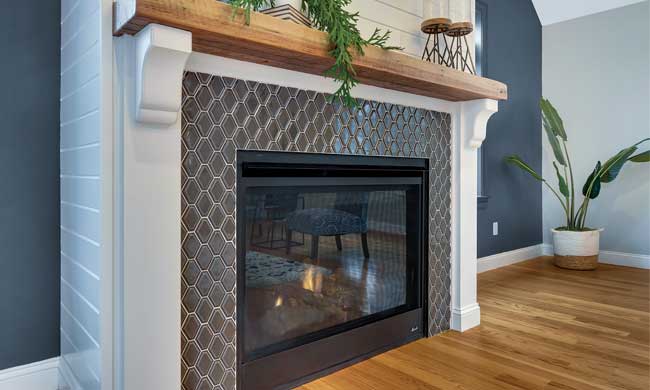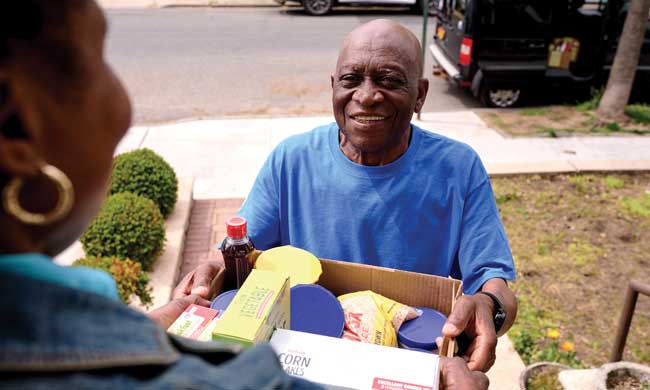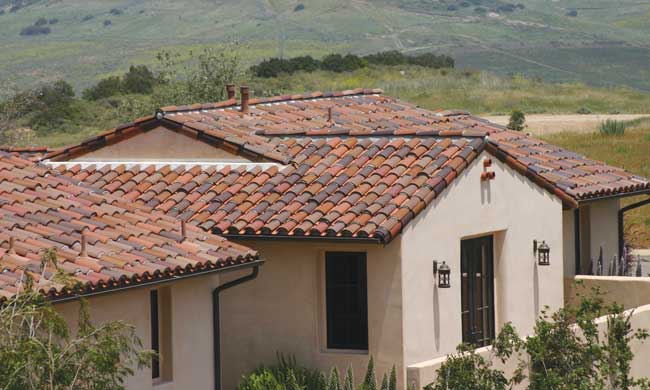Live Better
Clean heat: Stay warmer with clean energy

(Family Features) Winter is a perfect time to think about renovations that bring coziness and warmth to your home. For homeowners who live off the natural gas line, propane is an earth-friendly option that can reliably and efficiently deliver warmer air all season long.
“When homeowners upgrade to propane during a remodel, they transform a dream home to include comfort and performance with high-efficiency appliances that have low-carbon footprints,” said Susan Kadilak, owner of Kadilak Homes, a construction, renovation and interior design firm. “Not only do families stay warmer with propane, they can feel better doing so because it’s clean energy.”
If you’re considering upgrades to bring more warmth to your home, start with these tips from Kadilak Homes and the Propane Education & Research Council:
- Do your research. Talk with your contractor about what you’re wanting to accomplish. Your local propane supplier is also equipped to help you navigate questions and find the right solution for your home.
- Think cozy. If your electric furnace is struggling to keep a room warm, consider upgrading to a propane furnace to get to your desired temperature more efficiently. Propane furnaces blow hotter air, which is more comfortable than the below-body-temperature air electric heat pumps produce. Propane furnaces also emit up to 50% fewer greenhouse gas emissions than electric furnaces, according to the 2018 Gas Technology Institute Report, so you can feel good about your impact on the environment.
- Make your home more efficient. As homes age, small cracks can develop around doors and windows and let cold air inside your home or allow warm air to escape. If the seals around the windows and doors are damaged, invest a few minutes to replace them and spend time caulking gaps. When your home is well-insulated, propane can efficiently keep your home toasty during chilly winter months.
Some of the most common clean energy heating upgrades homeowners request include fireplaces, furnaces and boilers.
Fireplaces
A roaring fire can be a focal point during the cold winter months. With 5-6 times the heating capacity of electric fireplaces, propane fireplaces are more energy efficient, environmentally friendly, convenient to use and easier to install than wood-burning models, Kadilak said. Some parts of the United States are banning wood-burning fireplaces due to their negative effects on the environment. Propane-powered fireplaces are an alternative that emit less soot and other air-polluting emissions. You can enjoy a toasty fire at the flip of a switch with no ash or soot to clean up and no firewood to store. Many models can also operate during electrical power outages, providing a critical source of heat to the home.
Furnaces
There can be a bone-chilling feeling when the furnace goes out in the middle of a cold winter. If your furnace is blowing cold air – or no air at all – it’s time for an upgrade. Before you buy, know propane-powered furnaces have 50% longer lifespans than electric heat pumps, which reduces their overall lifetime cost for homeowners. Propane furnaces also provide warmer air than other heat sources, at 120-140 F.
Boilers
While furnaces rely on forced warm air to heat dwellings, boilers use hot water or steam to raise temperatures in homes. High-efficiency propane boilers offer performance, space savings and the versatility to provide heating, hot water and snow melting. This versatility also extends to the type of heating delivery system propane boilers serve, including hydronic baseboard systems, in-floor hydronic systems or forced-air systems where the hot water from the boiler (instead of a furnace) acts as the heat source.
Learn how propane can help keep your home cozy, including where you can find a propane supplier in your area, at propane.com/KadilakFireplaces.
10 Winter Safety Tips for a Propane-Fueled Home
If your home uses propane to generate heat or run appliances, there are some simple steps you can take to help keep your family safe and avoid potential dangers this winter.
1. Make sure you have an adequate propane supply. Schedule regular winter visits with your propane supplier so you always have an adequate supply in your tank.
2. Mark the location of your tank with a flag, pole or stake. Ensure it is higher than the average snow cover depth for your location. These markers can help you avoid plowing or shoveling rooftop snow on top of your tank. Should your tank become covered with snow, use a broom to clear it.
3. Make sure your heating system and appliances are running efficiently. Before the start of each heating season, have a qualified service technician inspect and service your appliances and propane system. This can help ensure your appliances are running as efficiently as possible.
4. Create an emergency preparedness plan and review it with everyone in your family. Post a list with contact information for your propane supplier and emergency services along with instructions for turning off propane, electricity and water. If you need to turn off your propane, contact a service technician to inspect your propane system prior to turning it back on.
5. Prepare a family disaster supply kit. Include several days’ worth of water and canned foods, along with a can opener, extra clothes, blankets, flashlights and batteries. Also include a battery-powered weather radio so you can stay informed as conditions change.
6. Check your chimneys, flue pipes, vent connectors and propane tank for damage, blockage or debris caused by snow and ice. Use a broom rather than a shovel and clear these areas frequently to help reduce the possibility of carbon monoxide poisoning.
7. Consider installing UL-listed propane gas detectors and carbon monoxide detectors. These detectors can provide you and your family with an additional measure of security. Be sure to follow the manufacturer’s instructions regarding installation, location and maintenance.
8. After a storm passes and it is safe to do so, check the entire area for downed power lines, damaged gas lines or damage to your propane tank. Immediately call your local utility company or propane supplier if any of these hazards exist. Do not attempt repairs yourself.
9. Never use a stove for space heating and never use outdoor propane appliances indoors or in enclosed areas, particularly in the event of a power outage. Proper ventilation is necessary for safe operation, and the carbon monoxide fumes can be lethal. Only use appliances indoors that are designed and approved for indoor use. Never store, place or use a propane cylinder indoors or in an enclosed area.
- Conserve energy. Keep thermostats at 65 F during the day and 55 F at night, and close off any rooms that don’t need to be heated.
Live Better
Finding the perfect volunteer opportunity for you

(Family Features) Tom Thousand spent many years helping low-income residents with home repairs. After retirement, he knew he wanted to continue helping people in his free time.
He answered the call to serve through AmeriCorps Seniors RSVP. Since 2010, he has volunteered to deliver meals to those in need, transported donated food to food pantries and captained boats on a nearby lake for group trips. Thousand was there when his neighbors needed rides to medical appointments and the Red Cross needed help delivering blood in his community.
All across the country, AmeriCorps Seniors connects people aged 55 and older with opportunities to volunteer in their communities. The program matches each volunteer’s interests and skills with local non-profit organizations. More than 140,000 older Americans serve their communities yearly through three core programs – the RSVP Program, the Foster Grandparent Program and the Senior Companion Program.
Many older adults look for variety, flexibility and benefits when searching for a way to volunteer.
“Since it was established in 1971, our RSVP program has been one of the nation’s largest older adult volunteer programs,” said Atalaya Sergi, national director, AmeriCorps Seniors. “The program has a wide variety of service opportunities that allow volunteers to help address our nation’s most pressing challenges. For our volunteers, RSVP takes the guesswork out of choosing how and where to volunteer their time and energy.”
Opportunities vary by city and state, but the RSVP program offers volunteers diverse ways to serve through local organizations. Examples include packaging meals for people with disabilities or other older adults, working in a call center for fraud victims, coordinating poetry workshops at a community center to stimulate the minds of those participating or transporting cancer patients to medical appointments. Service could also involve workforce development and job training or providing disaster preparedness assistance.
There are even select programs specifically designed to support veterans.
Mark Piscatelli volunteers at veterans’ coffeehouses. Coordinated through his local AmeriCorps Seniors RSVP program, the coffeehouses allow veterans to gather and socialize with each other and with volunteers. The social setting creates a safe space, fostering community and stability for everyone involved. Guest speakers frequently visit and provide new and updated information to attendees on local and national veterans’ services.
“AmeriCorps Seniors has created a wonderful opportunity for me to learn about veterans, veterans’ issues, what they’ve experienced, what they currently experience and what some of their concerns are going forward,” Piscatelli said.
David Langlois, a fellow volunteer, concurs.
“I really think that the bottom line is to support our veterans,” he said.
Older adults need volunteer programs that fit their lifestyles and allow them to choose how, where and the frequency of their service. Commitments range from a few hours to 40 hours per week. This flexibility allows Piscatelli and his fellow volunteers to participate without feeling overwhelmed by time obligations.
Volunteering is more than a way to fill time, however. Research from sources such as the National Institute on Aging suggests that older adults who are engaged in social and community activities maintain mental and physical health longer than those who are not.
“After one year of service, 88% of our volunteers reported a decrease in feelings of isolation,” Sergi said. “Plus, 78% of volunteers felt less depressed. That uplifts spirits and significantly impacts and benefits people’s lives.”
Yolanda Dave is an example of the positive impact of volunteering on the community and the volunteers themselves. She started volunteering more than 20 years ago because helping her community with hunger, isolation and literacy issues empowered her to be part of the solution. It’s more than that, though. She also benefits from the experience.
“I love volunteering,” Dave said. “You meet wonderful people of all ages. I get to share my skills, my experience. It keeps me active, mentally and physically, which is very healthy.”
Volunteers like Thousand, Piscatelli, Langlois and Dave support people in need and strengthen their communities and neighborhoods. If you’re 55 or older and looking for the right volunteer opportunity, visit AmeriCorps.gov/YourMoment to explore opportunities near you.
SOURCE:
AmeriCorps Seniors
Live Better
On-trend ways to refresh your house in 2025: 3 trends for improving home design and function

(Family Features) Whether you’re looking to simply refresh your living space or planning a major home renovation, staying current with design trends not only enhances comfort and style but also boosts your house’s value.
As modern home design continues to evolve, trends are increasingly shifting toward long-term movements focused on versatility, sustainability and innovation. By embracing these elements in your 2025 updates, with these ideas from the experts at Westlake Royal Building Products – a leader throughout North America in innovation, design and production of high-quality, low-maintenance exterior and interior building products including siding, trim, mouldings, roofing, stone, windows, outdoor living and more – you can ensure your living space remains stylish and functional for years to come.
Incorporate Versatile Design Elements
Because homeowners’ tastes are continuously evolving, it’s important to take an adaptable design approach when creating unique and harmonious indoor and outdoor spaces. Using products that offer exceptional design versatility, including siding, trim, stone, roofing and other exterior elements, can allow your upgrades to transcend fleeting trends and maintain their relevance and appeal over time.
Similarly, homebuyers are moving away from cookie-cutter designs, seeking bold aesthetics that enhance curb appeal and distinguish their homes from others on the block. This shift toward personalized spaces that reflect individual tastes requires mixing textures, finishes and colors to transform both exteriors and interiors to create visually dynamic and unique looks. Blending materials like brick with vinyl siding, stone with wood or modern siding with rustic stone veneer can add depth and character to facades.
Choose Sustainable and Eco-Friendly Design
Homeowners are increasingly focused on sustainable and eco-friendly home designs to reduce their environmental impact, save on energy costs and create healthier living spaces. Complementing this trend, biophilic design is also gaining momentum as it seeks to strengthen the connection between indoor environments and nature. This approach goes beyond simply adding greenery, focusing on the use of natural light, improved ventilation and materials that mimic organic patterns and textures. Features like large windows, living walls and the use of natural materials, such as wood and stone, have become popular choices, blending sustainability with a deeper connection to the natural world.
Eco-friendly materials that use fewer raw materials, generate smaller carbon footprints and conserve water play a vital role in sustainable design and are in high demand. For example, reclaimed wood, recycled metal and low-VOC (volatile organic compounds) paints are popular choices due to their reduced environmental impact. Innovative products can also help reduce energy consumption like US Tile Clay Roofing, which is naturally reflective, 100% recyclable and, when paired with a cool roof system, can save homeowners up to 22% per year on heating and cooling costs compared to a standard composition asphalt shingle roof.
Seek Functional, Innovative Solutions
Driven by the evolving needs of homeowners, modular and easy-install systems, like panelized stone siding, are gaining popularity due to their ability to simplify installation while mimicking traditional materials such as stone or wood. These functional systems save time and can empower homeowners to tackle projects themselves.
In addition, the rising frequency of severe weather events is increasing demand for smart, weather-resistant materials that enhance homes’ aesthetic appeal and offer superior protection against extreme conditions. An option like Versetta Stone, which delivers the authentic look and feel of stone in an easy-to-install panelized format, offers wind resistance up to 110 miles per hour and carries a Class A fire rating. The stone siding features a tongue-and-groove system for perfect spacing, has a built-in rainscreen and can be installed almost anywhere using screws or nails without additional footings for support.
Find more home design trends and inspiration at WestlakeRoyalBuildingProducts.com.
Live Better
Autumn lawn maintenance tips for a healthy yard

(Family Features) As temperatures drop and the first frost approaches, it’s time to take steps to winterize your lawn to ensure a lush, green comeback next spring.
A thorough inspection can help you identify the needs of your lawn, allowing you to tailor your fall maintenance efforts more effectively. Look for signs of damage such as bare patches, thinning areas or discoloration, and take note of any weeds or pests that may have taken hold. This evaluation sets a foundation for the steps you should take to prepare your lawn for the next growing season.
From mowing one last time (on a lower setting to help minimize the risk of snow mold and other winter-related issues) to removing leaves and applying winterizing fertilizer, these tips can help ensure your lawn is ready for the colder months.
Rake and Remove Leaves
A quintessential autumn chore, raking leaves and removing other debris from your yard can make a significant difference for your lawn’s health. Leaves left on the ground can smother your grass, blocking sunlight and trapping moisture, which can lead to fungal growth and other issues.
Use a lightweight rake to avoid damaging the grass or use a mulching mower to shred leaves into smaller pieces that can decompose and provide nutrients for the soil. If you have a compost bin, fallen leaves can be a valuable addition, enriching your compost with organic matter.
Fertilize for Fall
Fertilizing is a critical component to aiding your lawn in replenishing nutrients that were depleted during the warmer months. A well-fed lawn recovers more quickly from stress and can establish strong roots before winter sets in.
Choose a high-quality, slow-release fertilizer specifically formulated for fall application and apply evenly across your lawn. Applying fertilizer in mid- to late-autumn ensures the nutrients are absorbed by the grass, fostering healthy growth and preparing it to withstand the colder months.
Overseed the Lawn
Overseeding involves spreading grass seed over your existing lawn to fill in bare spots and improve density. Particularly beneficial in the fall, as the cooler temperatures and increased moisture create ideal conditions for seed germination, the practice not only enhances the appearance of your lawn but also improves its resilience against diseases and environmental stress.
Choose a grass seed mix suitable for your climate and lawn type. After spreading the seed, lightly rake the lawn to ensure the seed makes contact with the soil. Water the area thoroughly and maintain consistent moisture until new grass is well established.
Find more tips to maintain your lawn and garden at eLivingtoday.com.
Photo courtesy of Shutterstock
SOURCE:
eLivingtoday.com
-

 NEWS2 years ago
NEWS2 years ago2 hurt, 1 jailed after shooting incident north of Nocona
-

 NEWS12 months ago
NEWS12 months agoSuspect indicted, jailed in Tia Hutson murder
-

 NEWS2 years ago
NEWS2 years agoSO investigating possible murder/suicide
-

 NEWS2 years ago
NEWS2 years agoWreck takes the life of BHS teen, 16
-

 NEWS1 year ago
NEWS1 year agoMurder unsolved – 1 year later Tia Hutson’s family angry, frustrated with no arrest
-

 NEWS1 year ago
NEWS1 year agoSheriff’s office called out to infant’s death
-

 NEWS2 years ago
NEWS2 years agoBowie Police face three-hour standoff after possible domestic fight
-

 NEWS2 years ago
NEWS2 years agoDriver stopped by a man running into the street, robbed at knifepoint





